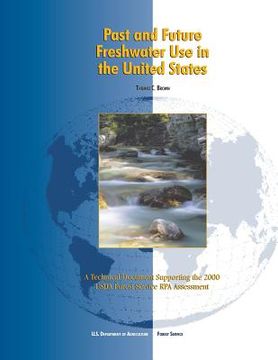Past and Future Freshwater Use in the United States: A Technical Document Supporting the 2000 USDA Forest Service RPA Assessment (en Inglés)
Reseña del libro "Past and Future Freshwater Use in the United States: A Technical Document Supporting the 2000 USDA Forest Service RPA Assessment (en Inglés)"
Water withdrawals to cities, farms, and other offstream uses in the United States have increased over ten-fold during the twentieth century in response to tremendous population and economic growth. Further rapid growth in population and income is almost certain to occur, placing additional demands on water supplies. As withdrawals to offstream users increase, more water is consumed, leaving less water in streams. Streamflows have dropped at the same time as additional instream uses have been found by scientists studying the needs of aquatic plants and wildlife and the hydro-geologic requirements of river channels themselves, and as rising incomes and urbanization have intensified calls for maintaining water-based recreation opportunities and protecting water quality (Gillilan and Brown 1997). These changes amplify the importance of examining the future adequacy of the nation's water supply. As Congress recognized when it passed the Forest and Rangeland Renewable Resources Planning Act of 1974 requiring the Forest Service to periodically assess anticipated resource supply and demand conditions, with sufficient forethought necessary adjustments may be anticipated and unnecessary costs may be avoided. The adequacy of a water supply depends on water availability compared with water demand. This report focuses on water demand, and estimates future water use assuming that the water will be available. Comparison of water-use estimates presented in this report with estimates of future water availability is left to a later report. In economic terms, demand is a price-quantity relation. Unfortunately, such relations are difficult to specify for some water uses and for large geographic regions containing numerous market areas. Thus, an economic model was not adopted for this study. Instead, demand, as used in this report, refers to quantity requested. This quantity-based approach leaves the effect of price unspecified but not avoided. Because water and the resources needed to manage it are scarce, price has played an important role in determining the past quantities of water requested and will continue to do so. In what follows, the implicit role of price must be remembered. Demand for water differs by region. Arid areas have higher demands per user than do humid areas, all else equal. Within a region of homogeneous weather, demands differ geographically depending on the availability of arable land, reliance on thermoelectric power, and other factors. The many potential differences among geographic areas suggest that demand for water should be studied at the smallest geographical scale possible. However, existing small-scale studies, often performed using different variables or methods, do not lend themselves to broadscale conclusions about regional or national trends. This report projects water demand to the year 2040. The time horizon was selected based on the Forest and Rangeland Renewable Resources Planning Act, which mandates that the Forest Service periodically prepare a management plan for a period of roughly 45 years into the future. Of course, the likelihood that a projection is accurate decreases as the time horizon of that projection increases. The objective of this paper is to characterize past and future water use in the U.S. A national perspective is first adopted to present a basic understanding of water-use trends. Then water use is described for large regions of the U.S. to capture the major regional differences.

